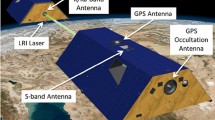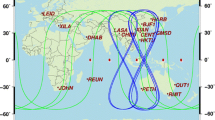Abstract
The GPS, DORIS, and SLR instruments are installed on Haiyang 2A (HY2A) altimetry satellite for Precise Orbit Determination (POD). Among these instruments, the codeless GPS receiver is the state-of-art Chinese indigenous onboard receiver, and it is the first one successfully used for Low Earth Orbit (LEO) satellite. Firstly, the contribution assesses the performance of the receiver through an analysis of data integrity, numbers of all tracked and valid measurements as well as multipath errors. The receiver generally shows good performance and quality despite a few flaws. For example, L2 observations are often missing in low elevations, particularly during the ascent of GPS satellites, and the multipath errors of P1 show a slightly abnormal pattern. Secondly, the PCO (Phase Center Offset) and PCV (Phase Center Variation) of the antenna of the GPS receiver are determined in this contribution. A significant leap for Z-component of PCO up to −1.2 cm has been found on 10 October 2011. Thirdly, the obtained PCO and PCV maps are used for GPS only POD solutions. The post-fit residuals of ionosphere-free phase combinations reduce almost 50%, and the radial orbit differences with respect to CNES (Centre National d’Etudes Spatiales) Precise Orbit Ephemeris (POEs) improve about 13.9%. The orbits are validated using the SLR data, and the RMS of SLR Observed minus Computed (O-C) residuals reduces from 17.5 to 15.9 mm. These improvements are with respect to the orbits determined without PCO and PCV. Fourthly, six types of solutions are determined for HY2A satellite using different combinations of GPS, DORIS, and SLR data. Statistics of SLR O-C residuals and cross-comparison of orbits obtained in the contribution and the CNES POEs indicate that the radial accuracy of these orbits is at the 1.0 cm level for HY2A orbit solutions, which is much better than the scientific requirements of this mission. It is noticed that the GPS observations dominate the achievable accuracy of POD, and the combination of multiple types of observations can reduce orbit errors caused by data gaps and maintain more stable and continuous orbits.
Similar content being viewed by others
References
Atamimi Z, Collilieux X, Métivier L. 2011. ITRF2008: An improved solution of the international Terrestrial Reference Frame. J Geodesy, 85: 457–473
Auriol A, Tourain C. 2010. DORIS system: The new age. Adv Space Res, 46: 1484–1496
Berger C, Biancale R, Barlier F, et al. 1998. Improvement of the empirical thermospheric model DTM: DTM94—A comparative review of various temporal variations and prospects in space geodesy applications. J Geo desy, 72: 161–178
Bertiger W I, Bar-Sever Y E, Christensen E J, et al. 1994. GPS precise tracking of TOPEX/POSEIDON: Results and implications. J Geophys Res-Oceans, 99: 24449–24464
Bertiger W, Desai S D, Dorsey A, et al. 2010. Sub-centimeter precise orbit determination with GPS for ocean altimetry. Mar Geodesy, 33: 363–378
Cerri L, Berthias J P, Bertiger W I, et al. 2010. Precise orbit determination standards for the Jason series of altimeter missions. Mar Geodesy, 33: 378–418
Choi K R. 2003. Jason-1 precision orbit determination using GPS combined with SLR and DORIS tracking data. Doctoral Dissertation. Austin: The University of Texas at Austin
Dejus M, Auriol A, Mercier F, et al. 2012. DORIS on HY-2A. IDS Workshop, Venice, Italy
Desai S D. 2002. Observing the pole tide with satellite altimetry. J Geophys Res-Oceans, 107: 3186–3198
Estey L H, Meerten C M. 1999. TEQC: The multi-purpose toolkit for GPS/GLONASS data. GPS Solut, 3: 42–49
Flechtner F. 2007. AOD1B Product Description Document. GRACE project document 327–750, Revision 3.1
Förste C, Bruinsma S, Shako R, et al. 2011. EIGEN-6-A new combined global gravity field model including GOCE data from the collaboration of GFZ-Potsdam and GRGS-Toulouse. EGU General Assembly 2011, Vienna, Austria
Fu L L, Christensen E J, Yamaron C A, et al. 1994. TOPEX mission overview. J Geophys Res-Oceans, 99: 24369–24381
Guo J, Zhao Q L, Li M, et al. 2013. GPS-derived cm level orbit for Hai-Yang 2A satellite (in Chinese). Geomat Inf Sci Wuhan Univ, 38: 52–55
Guo J Y, Kong Q L, Qin J, et al. 2013. On precise orbit determination of HY-2 with space geodetic techniques. Acta Geophys, 61: 752–772
Guo J Y, Qin J, Kong Q L, et al. 2012. On simulation of precise orbit determination of HY-2 with centimeter precision based on satellite-borne GPS technique. Appl Geophys, 9: 95–107
Haines B, Bar-Sever Y, Bertiger W, et al. 2004. One-centimeter orbit determination for JASON-1: New GPS-based strategies. Mar Geodesy, 17: 299–318
Hashemi Farahani H, Ditmar P, Klees R, et al. 2013. The static gravity model DGM-1S from GRACE and GOCE data: Computation, validation and an analysis of GOCE mission’s added value. J Geodesy, 87: 843–867
Hwang C, Tseng T P, Lin T J, et al. 2010. Quality assessment of FORMOSAT-3/COSMIC and GRACE GPS observables: Analysis of multipath, ionospheric delay and phase residual in orbit determination. GPS Solut, 14: 121–131
Jäggi A, Dach R, Montenbruck O, et al. 2009. Phase center modeling for LEO GPS receiver antennas and its impact on precise orbit determination. J Geodesy, 83: 1145–1162
Jiang X, Wang X, Peng H, et al. 2013. The technology of precise orbit determination for HY-2A satellite (in Chinese). Engineering Sci, 15: 19–24
Lemoine J M, Capdeville H. 2006. A corrective model for Jason-1 DORIS Doppler data in relation to the South Atlantic Anomaly. J Geodesy, 80: 507–523
Lemoine J M, Bruinsma S, Loyer S, et al. 2007. Temporal gravity field models inferred from GRACE data. Adv Space Res, 39: 1620–1629
Lemoine F G, Zelensky N P, Chinn D S, et al. 2010. Towards development of a consistent orbit series for TOPEX, Jason-1, and Jason-2. Adv Space Res, 46: 1513–1540
Luthcke S B, Zelensky N P, Rowlands D D, et al. 2003. The 1-Centimeter Orbit: Jason-1 precision orbit determination using GPS, SLR, DORIS and altimeter data. Mar Geodesy, 26: 399–421
Lyard F, Lefevre F, Letellier T, et al. 2006. Modelling the global ocean tides: Modern insights from FES2004. Ocean Dyn, 56: 394–415
McCarthy D D, Petit G. 2004. IERS Conventions (2003). IERS Technical Note No. 32. IERS Conventions Centre
Marshall J A, Luthcke S B. 1994. Modeling radiation forces acting on TOPEX/POSEIDON for precision orbit determination. J Spacecraft Rockets, 31: 99–105
Montenbruck O, Kroes R. 2003. In-flight performance analysis of the CHAMP BlackJack GPS Receiver. GPS Solut, 7: 74–86
Ogaja C, Hedfors J. 2007. TEQC multipath metrics in MATLAB. GPS Solut, 11: 215–222
Pavlis N K, Holmes S A, Kenyon S C, et al. 2012. The development and evaluation of the Earth Gravitational Model 2008 (EGM2008). J Geophys Res Sol Earth, 117: B04406
Pearlman M R, Degnan J J, Bosworth J M. 2000. The International Laser Ranging Service. Adv Space Res, 30: 135–143
Schmid R, Rothacher M, Thaller D, et al. 2005. Absolute phase center corrections of satellite and receiver antennas: Impact on global GPS solutions and estimation of azimuthal phase center variations of the satellite antenna. GPS Solut, 9: 283–293
Schmid R. 2011. Upcoming switch to IGS08/igs08.atx-Details on igs08.atx. IGSMAIL-6355, available on http://igs.org/pipermail/igsmail/2011/006347.html
Tapley B D, Ries J C, Davis G W, et al. 1994. Precise orbit determination for TOPEX/POSEIDON. J Geophys Res-Oceans, 99: 24383–24404
Willis P, Fagard H, Ferrage P, et al. 2010. The international DORIS service, toward maturity, in DORIS: Scientific application in geodesy and geodynamics. Adv Space Res, 45: 1408–1420
Willis P, Argus D, Cerri L, et al. 2011. DPOD2008: A DORIS terrestrial reference frame for precise orbit determination. OSTST Meeting, San Diego, USA
Wu B. 2012. ILRS SLR mission support request form retroreflector information for HY2A. Available on http://ilrs.gsfc.nasa.gov/docs/HY2_retroreflector.pdf
Yunck T P, Bertiger W I, Wu S C, et al. 1994. First assessment of GPS-based reduced dynamic orbit determination on TOPEX/Poseidon. Geophys Res Lett, 21: 541–544
Zelensky N P, Lemoine F G, Ziebart M, et al. 2010. DORIS/SLR POD modeling improvements for Jason-1 and Jason-2. Adv Space Res, 46: 1541–1558
Zhao G, Zhou X H, Wu B. 2012. Precise orbit determination of Haiyang-2 using satellite laser ranging. Chin Sci Bull, 58: 589–597
Zhang Q, Zhang J, Zhang H, et al. 2013. The study of HY-2A satellite engineering development and in-orbit movement (in Chinese). Engineering Sci, 15: 12–18
Ziebart M. 2004. Generalized analytical solar radiation pressure modeling algorithm for spacecraft of complex shape. J Spacecraft Rockets, 41: 840–849
Author information
Authors and Affiliations
Corresponding author
Rights and permissions
About this article
Cite this article
Guo, J., Zhao, Q., Guo, X. et al. Quality assessment of onboard GPS receiver and its combination with DORIS and SLR for Haiyang 2A precise orbit determination. Sci. China Earth Sci. 58, 138–150 (2015). https://doi.org/10.1007/s11430-014-4943-z
Received:
Accepted:
Published:
Issue Date:
DOI: https://doi.org/10.1007/s11430-014-4943-z




